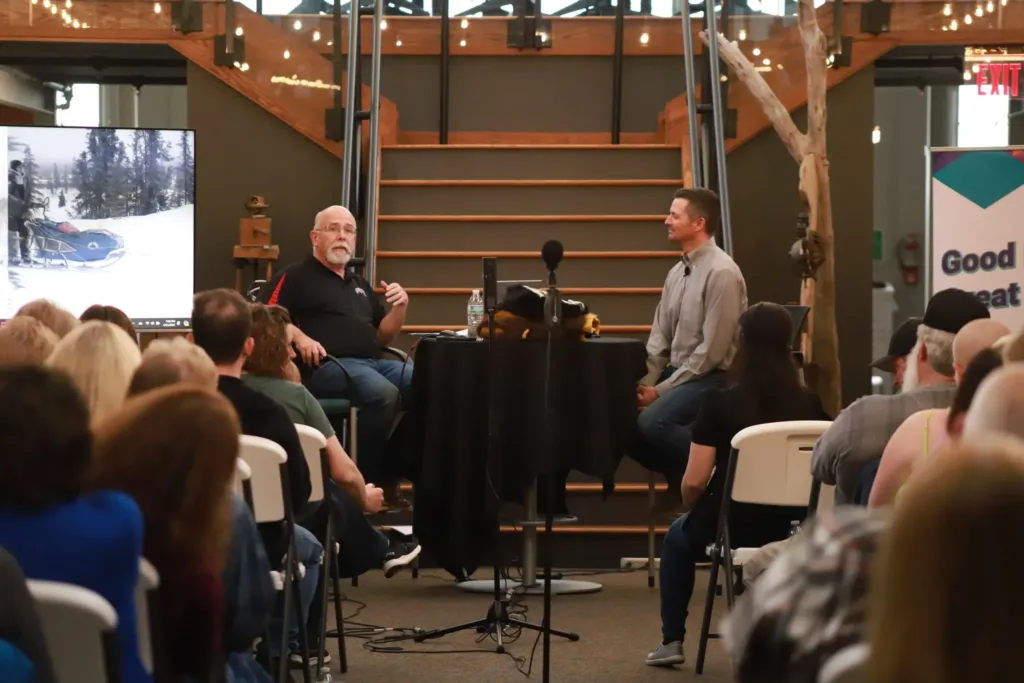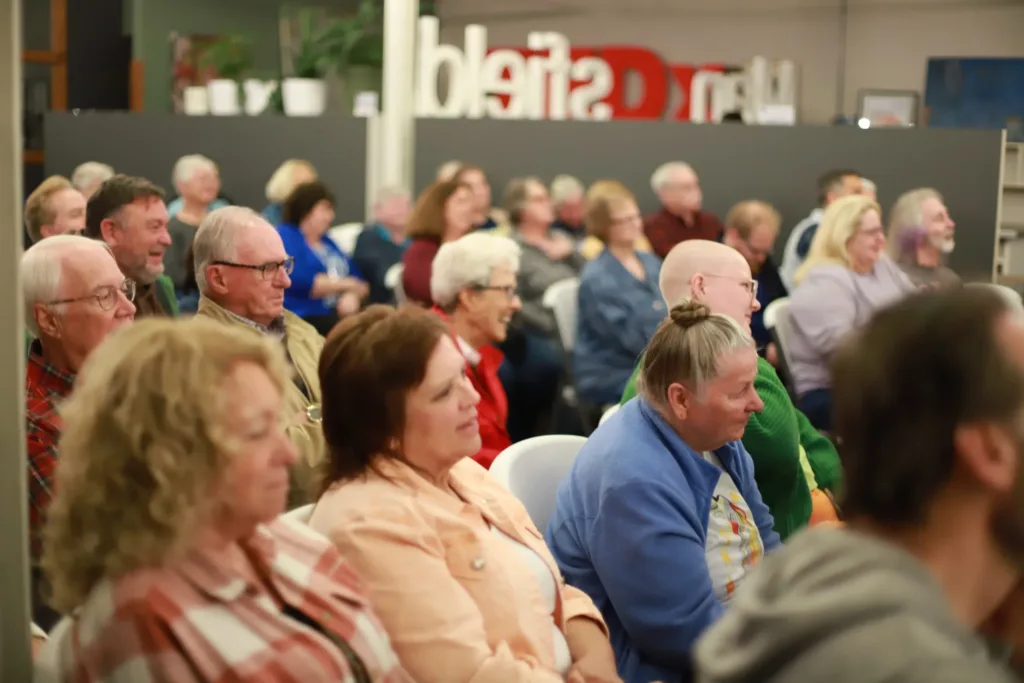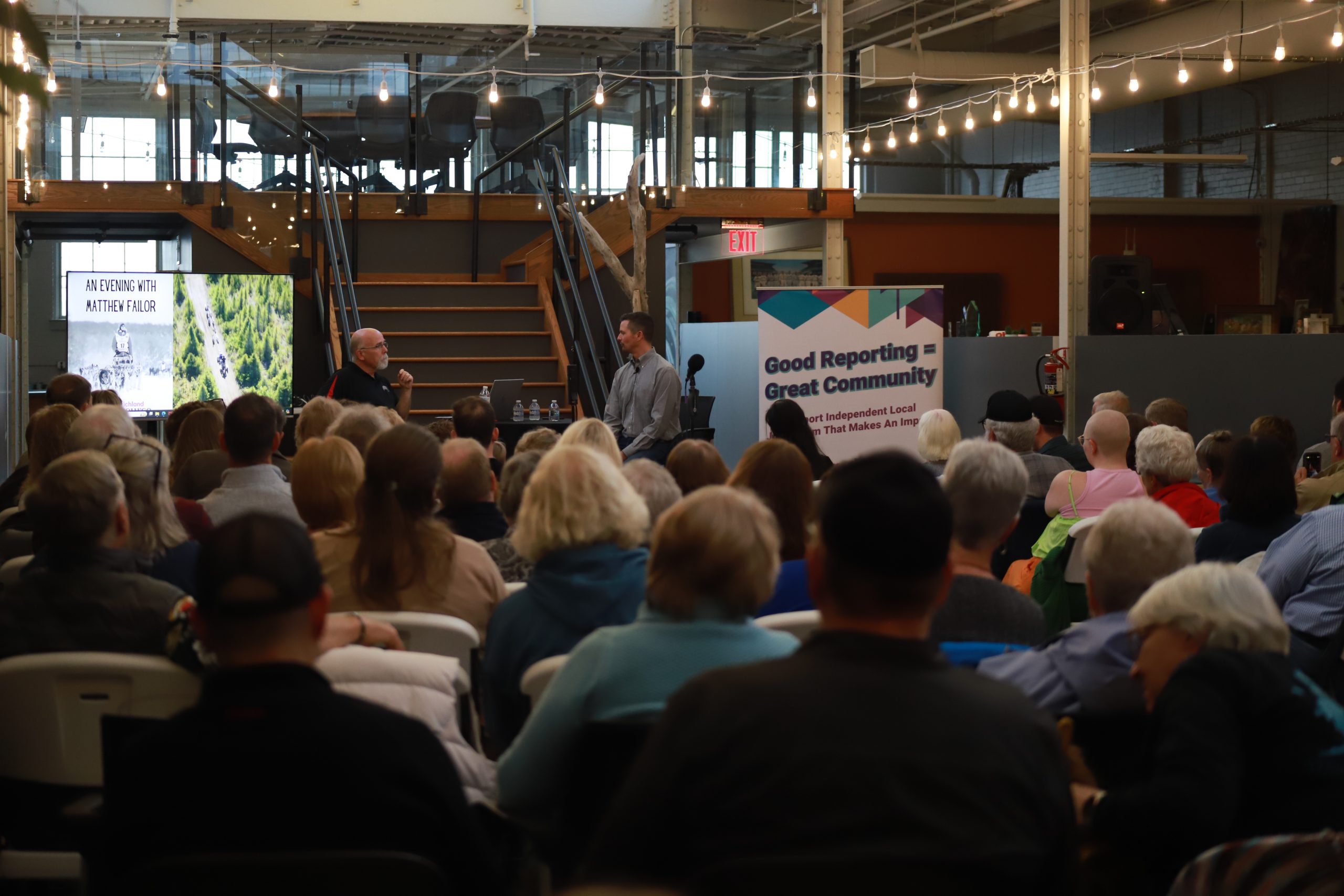If there’s one thing I’ve learned working in engagement journalism over the years, it’s that throwing an event is hard work.
You’ve got to book a venue, caterers and speakers. Coordinate schedules. Market your event and pray people actually show up. All this on top of balancing the daily workload of, you know, actually being a reporter.
There’s a reason event planning is a separate career path — one that none of us in the journalism industry actually chose — yet those doing engagement work often take this on as a separate role.
Here’s the good news: When you do this kind of work often enough, it gets easier. You learn to distill the process down to a few essential elements and trim the unnecessary details (which in turn often trims down your budget).
These lessons were essential at Richland Source when we had the opportunity to host an event with a local hometown hero — but we only had two weeks to pull it off.
THE INSPIRATION

Lead dog Sonic Boom gives Matthew Failor kisses on top of the last mountain before mushers cruise down to the Bering Sea and Safety in the Iditarod sled dog race.
The Iditarod Trail Sled Dog Race is a 938-mile race across Alaska, from Anchorage to Nome. It’s not exactly the type of event our news organization usually covers, except when we have a Mansfield native in the race.
Matt Failor had competed in 12 other Iditarod races before, but this was the year we decided to take a chance and go all-in on coverage of his journey across the Alaskan tundra. Following his progress on the Iditarod Insider, we published a story at 8 a.m. every day of the race in early March.
By the time Failor finished his run in 13th place over 10 days, 2 hours and 35 minutes, we’d written 11 stories about his journey. Those 11 stories generated more than 31,000 page views, 19,000 visitors and an average engaged time of 2:47.
Based on the numbers alone, we knew we had an audience for this kind of content. We casually thought about asking Failor to host a talk with us the next time he was in his hometown.
Then on March 25, we found out Failor would be visiting Mansfield and free the night of April 11 to participate in an event. That’s when the machine started rolling.
HOW WE DID IT
Time was not on our side when planning this event, so it was essential that we made fast, decisive choices. This is where years of practice came in handy.
For example…
- What is the event format? We knew the purpose of this event was to give our audience an opportunity to learn more about Failor and the Iditarod, so a Q&A format was the obvious choice. City editor Carl Hunnell, who wrote all the stories about Failor’s race, would act as moderator and interview Failor before we opened it up to questions from the audience.
- Where should we host? In our newsroom, because it’s free and we don’t have to worry about coordinating schedules with another venue. Maybe it wouldn’t be as big of a venue as we would’ve liked, but the pros outweigh the cons.
- Who should we invite? Since we knew we were limited on space (our newsroom can comfortably accommodate about 75 people) we had a pre-sale for Source Members. These are people who financially support us, so it was a nice extra perk for them to have access to this exclusive event. Then we opened it up to the public.
- Do we charge admission? That was a new question for us since most of our events are free. But we knew that Failor had suggested donating ticket proceeds to the Richland County Humane Society, an organization near and dear to him. So we charged $10 for Source Members (again, another perk) and $20 for the general public.
- Should we have food? Again, in the interest of time and schedules, we decided picking up a cookie tray and bottles of water was the best choice instead of asking a caterer to provide hors d’oeuvres.
- How do we track RSVPs? We have reliably used Eventbrite over the years and already had an account, so that was the natural choice to create an event and ask for RSVPs. We promoted it via email and a preview story on our site.
We also only involved essential team members in the planning process so that we could be more nimble in our decision-making. In addition to Hunnell, our head of community investment Leah Gesouras is the main contact for our members and an experienced event coordinator, so they were both natural collaborators on this project.
THE RESULT

Richland Source city editor Carl Hunnell (left) interviews Iditarod racer Matthew Failor during a reader engagement event at Source headquarters in Mansfield, OH. (Credit: Brittany Schock)
We published a story on March 28 advertising “An Evening with Matt Failor” to the public.
The event sold out within 10 hours, and we raised more than $1,000, all donated to the Richland County Humane Society.
I’ve thrown a lot of events at the Source, and that has never happened before. Here are my two main theories as to why this one popped:
- We knew we had an audience. Remember, our Matt Failor coverage had more than 31,000 page views in just 11 days. Using analytics to make decisions on what kinds of events to host is like having a cheat code. If your audience is showing interest online, there’s a good chance they’ll show interest in person, too.
- We gave back to the community. This was the first time we charged for an event, but it all went to a good cause (and who doesn’t love cute dogs?). In the future, I might not give all the proceeds away, but it was a successful experiment on mutual benefits. How can your event be a win-win for other organizations your community cares about?
In the end, the event was a smash hit. Failor was a great speaker who brought photos and souvenirs from Alaska to share, and it was nearly standing-room only in our newsroom.
We also made sure our reporters covered it, taking photos (useful for showing proof of concept later) and even recording the entire conversation for those who couldn’t attend. Because after all, even though it was an exclusive event, our main goal as an organization is to share stories.
TIPS FOR THE FUTURE
Our newsroom usually takes a “go big, or go home” approach to event planning. This results in awesome events like a 10-year anniversary block party or a community baby shower — but those kinds of blowouts aren’t sustainable.
 The Matt Failor event proved to us that not only could we throw together an event in two weeks’ time, but we could make money, too.
The Matt Failor event proved to us that not only could we throw together an event in two weeks’ time, but we could make money, too.
With that in mind, here are our top practical tips for newsrooms interested in throwing more small-scale events that are quick turnarounds:
- Draw up an event playbook. The main reason we were able to put together an event in two weeks is because we knew exactly what needed to be done, and what questions to ask. I recommend answering those questions for yourself before you even plan an event, to make decisions that much faster and easier.
- Use your coverage to fan reader interest. We knew this was important to act on because Matt Failor was a Mansfield native who had ties to the community, and people were following his progress like it was the Olympics. The audience was already there, we just had to bring them together.
- Look for community partners. The worst someone can say is “no.” Who has a similar mission and could bring the audience you’re looking for? Who’s already doing this work that you could partner with? Invite your community to do journalism alongside you.
- Get your team together. Look internally and delegate who can do what — and just as important, decide who doesn’t need to be involved. Lean into each person’s skills in your news organization, across all departments. Work smarter, not harder.
- Don’t worry about being perfect. Like I said, we’re journalists, not event planners. Your goal is to bring people together and have fun. Your readers will understand and love the effort no matter what.
Brittany Schock is the Audience Engagement Editor at Richland Source, with offices based in Mansfield, OH. She has over a decade of journalism experience, and has been a practitioner of solutions journalism since 2016. Her award-winning work has been nationally recognized by the Solutions Journalism Network, LION Publishers and the Knight Foundation, and she’s been invited to represent the Source in conversations about solutions and engagement journalism all over the world.
Share with your network
- 4 ways outlets are convening community — and seeing loyalty and revenue follow
- How a quick-turn template for newsroom events can maximize your engagement efforts — and even bring in revenue
- The next drink is on us: how we invited our readers into the newsroom and lived to tell the tale
- Local news can provide a ‘third space’ — and it makes financial sense. Here’s how we did it.
- How two newsrooms partnered to plan an event based on an Oscar-nominated movie
You also might be interested in:
What if we started looking at our output as a product, not a service? Too often, we think "product" means a fancy app or a new website. But product isn’t about tech. It’s about intention.
When we began asking what kind of stories still mattered to Baca County, we realized many of them weren’t “breaking news” but generational memory. And the paper was the last remaining platform that treated those memories with care and context.
Leaning into local identity and history can move our journalism from ‘we provide facts alone’ to ‘we provide facts and serve other important community functions.’



